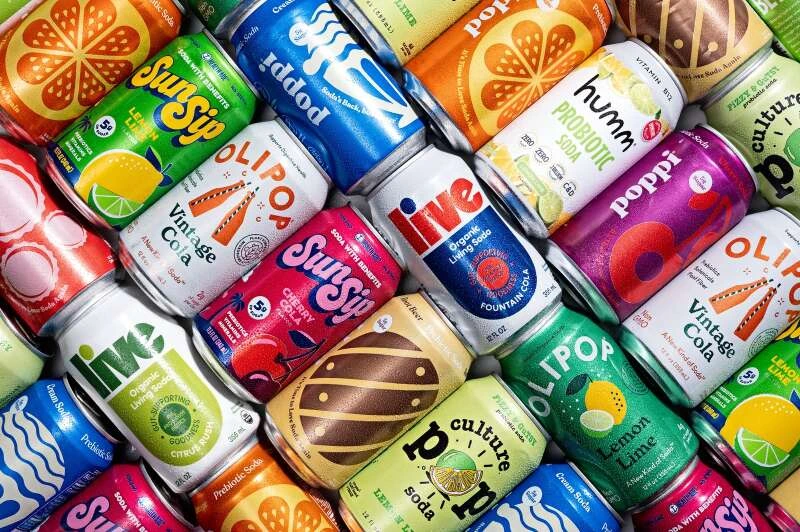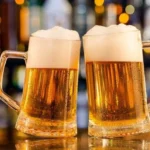
We all know the fizzy, sweet allure of a cold soda on a hot day. From the satisfying pop of the can to that first refreshing gulp, sodas have become a ubiquitous part of our daily lives and culture. But beyond being just a sugary treat, these bubbly beverages hold a surprising history, fascinating tidbits, and even some startling truths you might not be aware of. Get ready to have your perceptions challenged as we dive into a collection of truly interesting facts about sodas that will make you look at your next fizzy drink in a whole new light!
A 2010 study revealed a surprising finding regarding soda consumption and health: individuals who regularly consumed both diet and regular soda exhibited a greater accumulation of fat around their waistline compared to those who abstained from all types of soda. This suggests that even seemingly “healthier” diet soda options may not prevent central obesity and could potentially contribute to it, challenging common perceptions about their impact on body composition.
Warm Dr Pepper held a unique cultural significance in the southern United States throughout the 1960s. This sweet, syrupy concoction was not merely a beverage but was also believed to possess medicinal properties, often consumed to alleviate symptoms of colds and other minor ailments. Beyond its purported health benefits, warm Dr Pepper was a beloved staple at Christmas parties, adding a distinctive flavor to festive gatherings of the era.
The origins of many popular soda drinks today can be traced back to pharmacies in the late 19th and early 20th centuries, where they flourished as part of the burgeoning pharmaceutical industry. Initially, these early sodas were not just refreshments but were actively marketed as “cure-alls,” promising relief from a wide array of conditions including impotence, stomach pain, scurvy, alcoholism, opium addictions, and nervousness, reflecting a historical period where the lines between medicine and consumer beverages were significantly blurred.
A standard 12-ounce can of regular Coke contains a significant amount of sugar, totaling 39 grams, which is equivalent to approximately 9 1/3 teaspoons of sugar. This high sugar content highlights the substantial contribution of a single serving of regular soda to an individual’s daily sugar intake, a concern given the widespread consumption of such beverages.
Americans’ consumption of Coca-Cola alone accounts for over 1.7 million tons of sugar annually. This staggering figure translates to an average of 10.8 pounds of sugar per person per year consumed solely from Coca-Cola products. Overall, soda stands as the largest single source of added sugar in American diets, underscoring its significant role in the nation’s total sugar intake.
Individuals who operated soda fountains were colloquially known as “soda jerks.” This distinctive moniker originated from the specific, classic jerking motion they employed to efficiently pump soda water from the dispenser, a defining characteristic of their craft in the vibrant soda fountain establishments of the past.
Coca-Cola’s production demands a substantial amount of resources, with the company utilizing over 300,000 tons of aluminum for its cans each year within the United States alone. This considerable volume represents 17.4% of the entire U.S. aluminum production, illustrating the immense material footprint of the beverage industry, particularly for a leading brand like Coca-Cola.
Brominated vegetable oil (BVO), a toxic flame retardant, remains present in many American soft drinks, including products from Dr Pepper/Seven Up, Inc. such as Squirt, Sun Drop, and Sunkist Peach and Fruit Punch flavors, despite being banned in Europe and Japan. This continued inclusion of BVO in certain U.S. beverages raises concerns about regulatory differences and potential health implications for consumers.
The designation of “soft drinks” serves to distinguish them from “hard drinks,” which is the term used to refer to alcoholic beverages. This nomenclature emphasizes the non-alcoholic nature of sodas and similar beverages, setting them apart from intoxicating drinks.
Coca-Cola holds the distinction of being the most widely distributed product on the planet, a testament to its pervasive global presence. To illustrate its immense reach, if every single drop of Coke ever produced were contained in 8-ounce bottles and laid end to end, these bottles would extend to the moon and back over 2,000 times, a vivid demonstration of its unparalleled production volume and distribution network.
The term “soda” is derived from the word “sodium,” a mineral commonly found in natural spring water, reflecting the historical connection between these springs and early carbonated beverages. The word “pop” first emerged in 1812, specifically referencing the distinct sound produced when a carbonated beverage bottle is opened, capturing the auditory experience of enjoying such a drink.
In various regions of the U.S. and Canada, carbonated soft drinks are referred to by different terms, including “pop,” “soda,” or generically as “coke.” Across the Atlantic, the English typically call them “fizzy drinks,” while the Irish use the term “minerals,” showcasing the diverse regional nomenclature for these popular beverages.
The Academy of General Dentistry has issued a cautionary statement highlighting that the levels of acid found in sodas are comparable to the acidity of battery acid. This dangerously high acidic content, in combination with the equally high sugar content prevalent in sodas, significantly contributes to the erosion of tooth enamel, a process that can occur even with minimal exposure to these drinks.
A concerning study revealed that 48% of sodas tested from fast food fountains contained coliform bacteria. This type of bacteria is associated with fecal matter and, even more alarmingly, was found to be resistant to 11 different types of antibiotics, raising significant public health and hygiene concerns regarding the cleanliness of fast food soda dispensers.
7-Up was originally marketed under the lengthy name “Bib-Label Lithiated Lemon-Lime Soda.” Until the 1950s, this beverage notably contained lithium citrate, which is a drug recognized for its mood-stabilizing properties, illustrating a fascinating historical link between soft drinks and pharmaceutical components.
Today, Americans consume an astonishing average of approximately 50 gallons of soda per person annually. This high per capita consumption underscores the pervasive presence of soda in the American diet and its significant contribution to overall beverage intake.
Many sodas contain phosphoric acid, an ingredient that has been linked to several negative health outcomes. Research suggests that phosphoric acid may increase the risk for osteoporosis, contribute to bone loss, and accelerate tooth decay, raising concerns about the long-term skeletal and dental health impacts of frequent soda consumption.
A&W root beer derives its name from the initials of its two founders, Roy W. Allen and Frank Write. A&W is also recognized as one of the pioneering franchised restaurant chains in the United States, signifying its historical importance in the development of both beverage and food service industries.
While several companies, including Moxie, Dr Pepper, Vernors Ginger Soda, and Hire’s Root Beer, lay claim to being the oldest soft drink brand in America, all of which emerged in the late 19th century, the first artificially carbonated drink was actually created much earlier, in 1767, by the Swedish chemist Joseph Priestley, establishing a significant milestone in the history of carbonated beverages.
Dr Pepper is uniquely categorized not as a cola but rather as a “distinctly flavored drink.” This classification is strategically advantageous, allowing Dr Pepper to be sold in both Pepsi and Coke soda fountains and vending machines, bypassing the usual exclusivity agreements. Furthermore, the period in “Dr. Pepper” was intentionally dropped in the 1950s to distance the brand from any suggestion of a medical association.
Pepsi-Cola began its journey in 1898 as a carbonated soft drink initially known as “Brad’s Drink.” This early iteration was created by its founder, pharmacist Caleb Bradham, in North Carolina, marking the humble beginnings of what would become one of the world’s most recognizable beverage brands.
Glass bottles are demonstrably superior to plastic containers when it comes to preserving the carbonation of soda. This is because carbon dioxide can gradually escape through the permeable material of plastic, leading to a loss of fizziness. Consequently, carbonated beverages stored in plastic have a much shorter shelf life compared to soda stored in glass, which better maintains its effervescence.
Fanta’s origins are rooted in a surprising historical context: it was created in Germany during World War II. The exigencies of wartime, specifically trade embargoes imposed against the Nazis, compelled German bottling plants to innovate and develop their own soda formulas, leading to the birth of this now globally recognized beverage.
Pepsi’s popular marketing slogan “Come alive with Pepsi” encountered a significant cultural misstep when translated into Chinese. The unfortunate translation rendered the slogan as “Pepsi brings your ancestors back from the grave,” highlighting the critical importance of careful linguistic and cultural considerations in international advertising campaigns.
The name “Mountain Dew” is actually a slang term for “moonshine,” a reference that hints at its original purpose. Mountain Dew was initially conceived and popularized as a mixer for bourbon, underscoring its historical connection to alcoholic beverages before becoming a standalone soft drink.
Among popular sodas, Pepsi Max contains the highest caffeine content at 69 mg per 12 oz. serving. Mountain Zevia follows with 55 mg per 12 oz., and Mountain Dew (both regular and diet versions) comes in third with 54 mg per 12 oz. The FDA’s official limit for cola and pepper soft drinks is set at 71 mg per 12 oz. serving, providing a benchmark for caffeine levels in these beverages.
Studies indicate a distinct preference among men for sodas that avoid the term “diet” in their branding. Furthermore, these studies suggest men are also more drawn to soda cans featuring darker colors, such as black or red, pointing to specific marketing strategies that resonate with this demographic.
Researchers have observed a concerning trend where advertisers of soda and other types of junk food actively target minority and lower-income children. This demographic is exposed to a disproportionate amount of such advertising, seeing twice as many soda and junk food commercials compared to white children, raising ethical concerns about marketing practices and their potential impact on vulnerable populations.
Frequently Asked Questions About Sodas
1. What exactly is soda made of?
Sodas, also known as soft drinks or carbonated beverages, primarily consist of carbonated water, a sweetener, flavoring agents, and sometimes colorings, acids, and preservatives.
- Carbonated Water: This is the base of all sodas, created by dissolving carbon dioxide gas (CO2) into water under pressure, which gives soda its characteristic fizziness and bubbles.
- Sweeteners: The most common sweeteners are high-fructose corn syrup (HFCS) and sucrose (table sugar). Diet sodas use artificial sweeteners like aspartame, sucralose, or natural alternatives like stevia.
- Flavoring Agents: These are natural or artificial compounds that give each soda its unique taste, such as cola nut extracts, fruit flavors (lemon-lime, orange, grape), and spice extracts (ginger, root beer).
- Acids: Acids like phosphoric acid (common in colas) and citric acid (common in fruit-flavored sodas) are added for tartness and to act as preservatives, inhibiting bacterial growth.
- Colorings: Caramel color is frequently used in colas, while other artificial or natural food colorings are used to achieve the desired visual appeal.
- Preservatives: Ingredients like sodium benzoate or potassium benzoate are included to prevent the growth of microorganisms and extend shelf life.
- Caffeine: Many popular sodas, especially colas and some lemon-lime or dark-flavored drinks, contain caffeine as a stimulant and flavor enhancer.
2. Is soda bad for you? What are the main health risks associated with drinking soda?
In short, frequent consumption of soda, especially sugar-sweetened varieties, is widely associated with numerous negative health outcomes. The primary concerns stem from their high sugar content and acidity.
- Weight Gain and Obesity: Sodas are a major source of empty calories and added sugars. These liquid calories don’t provide the same feeling of fullness as solid food, leading to increased overall calorie intake and contributing to weight gain and obesity.
- Type 2 Diabetes: The rapid influx of sugar from sodas can cause significant spikes in blood sugar levels, leading to increased insulin resistance over time and significantly elevating the risk of developing type 2 diabetes. Studies have shown a strong correlation between regular soda consumption and diabetes development.
- Heart Disease: High sugar intake from sodas can negatively impact cardiovascular health by increasing triglyceride levels, lowering “good” HDL cholesterol, and potentially contributing to high blood pressure. These factors increase the risk of heart disease.
- Tooth Decay and Enamel Erosion: The combination of high sugar content and high acidity (comparable to battery acid in some cases, according to the Academy of General Dentistry) in sodas is extremely detrimental to dental health. Sugar feeds bacteria in the mouth, which produce acids that erode tooth enamel, leading to cavities and tooth decay.
- Bone Health: Some sodas, particularly those containing phosphoric acid, have been associated with an increased risk of osteoporosis and bone loss, potentially by interfering with calcium absorption.
- Kidney Disease: Frequent soda consumption has also been linked to an increased risk of kidney disease.
- Non-alcoholic Fatty Liver Disease: Excess sugar, especially fructose, is metabolized by the liver and can be converted into fat, contributing to the development of non-alcoholic fatty liver disease.
- Gout: Soda consumption has been associated with an increased risk of gout, a painful form of arthritis caused by high levels of uric acid in the blood.
- Gut Health: Some studies have found coliform bacteria, associated with fecal matter and antibiotic resistance, in fast food fountain sodas, raising concerns about hygiene.
3. How much sugar is typically in a can of soda?
The amount of sugar in soda can vary by brand and size, but it’s generally quite high. A standard 12-ounce can of regular Coca-Cola contains 39 grams of total sugar, which is equivalent to about 9 1/3 teaspoons of sugar. To put this in perspective, the American Heart Association recommends no more than 6 teaspoons (25 grams) of added sugar per day for women and no more than 9 teaspoons (36 grams) for men. This means a single can of soda can easily exceed daily recommended limits for added sugar.
4. What is the history of soda? When and where did it originate?
The concept of carbonated beverages dates back to the 18th century.
- 1767: The first artificially carbonated drink was created by Swedish chemist Joseph Priestley, who found a way to infuse water with carbon dioxide.
- Late 18th Century: Jacob Schweppe, a German watchmaker, perfected the process of carbonating water and began commercial production in 1783 in Geneva, Switzerland, leading to the creation of Schweppes.
- 19th Century (Pharmacies as Birthplaces): Most popular soda drinks today originated and flourished in pharmacies during the late 19th and early 20th centuries. Early sodas were often marketed as “cure-alls” for a variety of ailments, including impotence, stomach pain, scurvy, alcoholism, and nervousness. Pharmacists like John Pemberton (Coca-Cola, 1886), Caleb Bradham (Brad’s Drink, later Pepsi-Cola, 1898), and Charles Alderton (Dr Pepper, 1885) developed these drinks, often as medicinal tonics.
- Early 20th Century to Present: As their popularity grew, sodas transitioned from medicinal tonics to recreational beverages, becoming mass-produced and globally distributed.
5. Are diet sodas healthier than regular sodas?
While diet sodas are calorie-free and sugar-free, they are not necessarily a healthier alternative to regular sodas and carry their own set of concerns.
- Artificial Sweeteners: Diet sodas use artificial sweeteners (e.g., aspartame, sucralose, saccharin) or natural zero-calorie sweeteners (e.g., stevia). The long-term effects of these sweeteners are still being studied, and some research suggests potential links to changes in gut microbiota, increased cravings for sweet foods, and even an increased risk of type 2 diabetes and heart disease, similar to regular sodas.
- Weight Management: Despite being calorie-free, some studies indicate that people who drink diet beverages may consume more calories from food, potentially due to the psychological effect of “saving calories” or the way artificial sweeteners interact with appetite regulation. A 2010 study found that people who drank both diet and regular soda gained more fat around their waist than people who did not drink any soda.
- Dental Health: Although they lack sugar, the high acidity levels in most diet sodas can still contribute to tooth enamel erosion, similar to regular sodas.
6. What are the different types of soda?
Sodas come in a vast array of flavors and categories:
- Colas: The most popular type, characterized by their dark color and distinct flavor (e.g., Coca-Cola, Pepsi, Dr Pepper).
- Lemon-Lime Sodas: Clear or light-colored sodas with citrus notes (e.g., Sprite, 7-Up).
- Orange Sodas: Fruit-flavored sodas with an orange taste (e.g., Fanta Orange, Sunkist Orange).
- Root Beer: A distinct, often sweet and earthy flavor, traditionally made from the root of the sassafras tree (e.g., A&W, Mug).
- Ginger Ale/Ginger Beer: Sodas with a ginger flavor, ranging from mild (ginger ale) to spicy (ginger beer).
- Cream Sodas: Sweet, vanilla-flavored sodas with a creamy mouthfeel.
- Grape Sodas: Fruit-flavored sodas with a grape taste (e.g., Fanta Grape).
- Specialty/Regional Sodas: Many smaller brands or regional favorites offer unique flavors like birch beer, sarsaparilla, or various fruit-flavored drinks.
7. Why is it called “soda” or “pop”?
The terms “soda” and “pop” both have interesting origins:
- “Soda”: This term is derived from “sodium,” which was a common mineral found in natural spring water. When early carbonated beverages were created, methods often involved ingredients like sodium bicarbonate (baking soda) to produce the carbonation, leading to the association with “soda.”
- “Pop”: This word was first used in 1812 and refers to the distinctive sound made when opening a bottle of carbonated beverage, particularly the “pop” of the cork or cap releasing the pressure.
- Regional Variations: The usage of “soda,” “pop,” or even generically “coke” varies significantly across different regions of the U.S. and Canada. Across the Atlantic, the English often call them “fizzy drinks,” and the Irish refer to them as “minerals.”
8. Who invented carbonated water, the basis of soda?
The invention of artificially carbonated water is credited to Joseph Priestley, an English chemist. In 1767, he discovered a method to infuse water with carbon dioxide by suspending a bowl of distilled water above a beer vat in a brewery. This groundbreaking discovery laid the foundation for the development of all carbonated beverages, including soda.
9. How is soda manufactured?
The manufacturing of soda typically involves several key steps:
- Water Treatment: Raw water is filtered, purified, and treated to ensure consistent quality and taste.
- Syrup Preparation: A concentrated syrup is created by mixing sweeteners (sugar or artificial sweeteners), flavoring agents, acids, colorings, and preservatives in precise proportions.
- Carbonation: The purified water is chilled and then carbonated by injecting carbon dioxide gas under pressure. The level of carbonation varies by type of soda (e.g., colas often have around 3.5 volumes of CO2 per liquid volume, while some fruitier drinks have less).
- Mixing: The carbonated water is then mixed with the prepared syrup.
- Filling and Packaging: The finished soda is filled into cans, glass bottles, or plastic bottles. Glass bottles are generally better at holding carbonation as the gas can escape through plastic more easily, leading to a shorter shelf life for plastic-bottled sodas.
- Sealing and Labeling: The containers are sealed, labeled, and prepared for distribution.
10. What are some healthy alternatives to soda?
Given the health concerns associated with soda, many people seek healthier alternatives:
- Water: The best and most fundamental choice for hydration.
- Flavored Water: Infusing water with natural ingredients like sliced fruits (lemon, lime, berries), vegetables (cucumber), or herbs (mint, basil) for a refreshing, calorie-free drink.
- Sparkling Water (Plain or Flavored): Provides the fizziness of soda without the sugar. Opt for unsweetened varieties or add a splash of 100% fruit juice.
- Unsweetened Iced Tea: A refreshing option that can be made with various tea types (black, green, herbal) and customized with natural sweeteners like honey if desired.
- Kombucha: A fermented tea that offers probiotics for gut health, often with a slight fizziness and a tangy-sweet flavor.
- Herbal Teas: Hot or cold, these offer a wide range of flavors and potential health benefits without caffeine or sugar.
- Coconut Water: A natural source of electrolytes, offering a sweet and refreshing taste.
- Homemade Smoothies/Vegetable Juices: Can be rich in nutrients and fiber, with sugar content controlled by the ingredients used.
- Milk (in moderation): Provides calcium and other nutrients, and its alkalinity can help neutralize the acidity from other foods.
- Coffee (black or with minimal additions): For those seeking a caffeine boost without the sugar.
11. Do all sodas contain caffeine?
No, not all sodas contain caffeine. While many popular colas (like Coca-Cola and Pepsi) and some other dark-flavored or energy-focused sodas (like Mountain Dew or Pepsi Max) are caffeinated, many others are naturally caffeine-free or offered in caffeine-free versions. Examples of commonly caffeine-free sodas include Sprite, 7-Up, Fanta (most flavors), and many ginger ales and root beers. Caffeine content is typically listed on the nutrition label. For example, a 12-oz can of Coca-Cola contains 34mg of caffeine, while Diet Coke has 46mg, which is significantly less than the caffeine in an equivalent amount of coffee (140mg or more for 12oz).
12. Are there truly “natural” sodas available?
The term “natural” in relation to sodas can be complex, but there are brands that strive for more natural ingredients compared to conventional sodas. These typically focus on:
- Sweeteners: Using cane sugar (often vegan cane sugar, avoiding bone char processing), stevia, or other plant-based sweeteners instead of high-fructose corn syrup or artificial sweeteners.
- Colors and Flavors: Relying on natural extracts and fruit juices for flavor and color rather than artificial colorings and synthetic flavors.
- Avoiding GMOs: Some brands specifically state that their ingredients, particularly corn-derived components like HFCS, are non-GMO verified, given that a large percentage of the U.S. corn crop is genetically modified.
- Gluten-Free: Some sodas might contain gluten if caramel color derived from barley is used. “Natural” soda brands often ensure their products are gluten-free.









